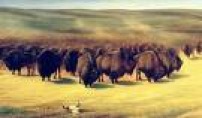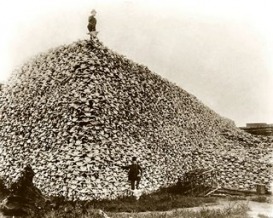The Buffalo: Symbol of the Plains Indians

Interview with Thomas Bowlus distinguished Professor of American Indian History and Director of the Center for Indigenous Nations Studies at the University of Kansas:
Q. Why is the buffalo important to Native Americans?
A. The buffalo is a great symbol and great being to the Plains people because it's really their staff of life and even more than that. The Plains Indians had developed their cultures, communities and way of life around the buffalo. At the utmost, the 24 to 28 Plains tribes had figured out how to use the buffalo in 52 different ways for food, supplies, war and hunting implements, things like that. And so, the hooves, for example, are boiled to use as glue. The hump back is, that part of the buffalo is really kind of sturdy, and so it's used for making shields, the hides for making a teepee, for example. It took about 12 to 14 hides to do that. The buffalo was indeed plentiful and was the most important natural resource to the Plains Indians.
Q. Why is the buffalo important to Native Americans?
A. The buffalo is a great symbol and great being to the Plains people because it's really their staff of life and even more than that. The Plains Indians had developed their cultures, communities and way of life around the buffalo. At the utmost, the 24 to 28 Plains tribes had figured out how to use the buffalo in 52 different ways for food, supplies, war and hunting implements, things like that. And so, the hooves, for example, are boiled to use as glue. The hump back is, that part of the buffalo is really kind of sturdy, and so it's used for making shields, the hides for making a teepee, for example. It took about 12 to 14 hides to do that. The buffalo was indeed plentiful and was the most important natural resource to the Plains Indians.
This interdependence between Indian and buffalo is exemplified in the words of John Fire Lame Deer:

The buffalo gave us everything we needed. Without it we were nothing. Our tipis were made of his skin. His hide was our bed, our blanket, our winter coat. It was our drum, throbbing through the night, alive, holy. Out of his skin we made our water bags. His flesh strengthened us, became flesh of our flesh. Not the smallest part of it was wasted. His stomach, a red-hot stone dropped into it, became our soup kettle. His horns were our spoons, the bones our knives, our women's awls and needles. Out of his sinews we made our bowstrings and thread. His ribs were fashioned into sleds for our children, his hoofs became rattles. His mighty skull, with the pipe leaning against it, was our sacred altar. The name of the greatest of all Sioux was Tatanka Iyotake--Sitting Bull. When you killed off the buffalo you also killed the Indian--the real, natural, "wild" Indian (Fire, 130)
Buffalo slaughter of the 1870s

Pile of buffalo skulls
The civilization of the Indian is impossible while the buffalo remains upon the plains. I would not seriously regret the total disappearance of the buffalo from our western prairies, in its effect upon the Indians, regarding it as a means of hastening their sense of dependence upon the products of the soil and their own labors.
--Annual Report of the Department of the Interior
There is no law that Congress can pass that will prevent the buffalo from disappearing before the march of civilization. There is no law which human hands can write, there is no law which a Congress of men can enact, that will stay the disappearance of these wild animals before civilization. They eat the grass. They trample upon the plains upon which our settlers desire to herd their cattle and their sheep. They range over the very pastures where the settlers keep their herds of cattle. They destroy the pasture. They are as uncivilized as the Indian."
--1874, U.S. Representative Conger
--Annual Report of the Department of the Interior
There is no law that Congress can pass that will prevent the buffalo from disappearing before the march of civilization. There is no law which human hands can write, there is no law which a Congress of men can enact, that will stay the disappearance of these wild animals before civilization. They eat the grass. They trample upon the plains upon which our settlers desire to herd their cattle and their sheep. They range over the very pastures where the settlers keep their herds of cattle. They destroy the pasture. They are as uncivilized as the Indian."
--1874, U.S. Representative Conger
